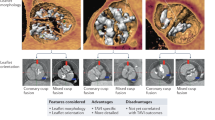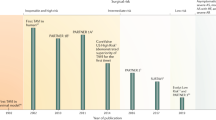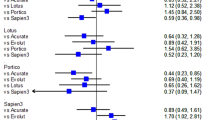Abstract
Transcatheter aortic valve implantation (TAVI) is an established therapeutic option for high-risk patients with tricuspid aortic valve stenosis. Historically, the presence of a bicuspid aortic valve (BAV) has been regarded as a contraindication to TAVI, on the basis of putative concerns about the associated risks of elliptical deployment, accelerated leaflet degeneration, periprosthetic leaks, and aortic complications. Fortunately, with technological refinements and mounting experience, reasonable success has been achieved with TAVI in selected patients with a BAV. The rate of procedural success is high, and survival is similar to that in patients with a tricuspid aortic valve who undergo TAVI. Nevertheless, moderate or severe aortic regurgitation and aortic dissection seem to occur more frequently in patients with a BAV rather than a tricuspid aortic valve. Specifically-designed prospective studies should address these concerns and help to define anatomical selection criteria before TAVI can be recommended for patients with a BAV.
This is a preview of subscription content, access via your institution
Access options
Subscribe to this journal
Receive 12 print issues and online access
$209.00 per year
only $17.42 per issue
Buy this article
- Purchase on Springer Link
- Instant access to full article PDF
Prices may be subject to local taxes which are calculated during checkout


Similar content being viewed by others
References
Kodali, S. K. et al. Two-year outcomes after transcatheter or surgical aortic-valve replacement. N. Engl. J. Med. 366, 1686–1695 (2012).
Smith, C. R. et al. Transcatheter versus surgical aortic-valve replacement in high-risk patients. N. Engl. J. Med. 364, 2187–2198 (2011).
Adams, D. H. et al. Transcatheter aortic-valve replacement with a self-expanding prosthesis. N. Engl. J. Med. 370, 1790–1798 (2014).
Cribier, A. et al. Percutaneous transcatheter implantation of an aortic valve prosthesis for calcific aortic stenosis: first human case description. Circulation 106, 3006–3008 (2002).
Leon, M. B. et al. Transcatheter aortic-valve implantation for aortic stenosis in patients who cannot undergo surgery. N. Engl. J. Med. 363, 1597–1607 (2010).
Roberts, W. C. The congenitally bicuspid aortic valve: a study of 85 autopsy cases. Am. J. Cardiol. 26, 72–83 (1970).
Basso, C. et al. An echocardiographic survey of primary school children for bicuspid aortic valve. Am. J. Cardiol. 93, 661–663 (2004).
Tutar, E., Ekici, F., Atalay, S. & Nacar, N. The prevalence of bicuspid aortic valve in newborns by echocardiographic screening. Am. Heart J. 150, 513–515 (2005).
Nistri, S., Basso, C., Marzari, C., Mormino, P. & Thiene, G. Frequency of bicuspid aortic valve in young male conscripts by echocardiogram. Am. J. Cardiol. 96, 718–721 (2005).
Zegdi, R. et al. Is it reasonable to treat all calcified stenotic aortic valves with a valved stent? Results from a human anatomic study in adults. J. Am. Coll. Cardiol. 51, 579–584 (2008).
Zegdi, R. et al. Increased radial force improves stent deployment in tricuspid but not in bicuspid stenotic native aortic valves. Ann. Thorac. Surg. 89, 768–772 (2010).
Wijesinghe, N. et al. Transcatheter aortic valve implantation in patients with bicuspid aortic valve stenosis. JACC Cardiovasc. Interv. 3, 1122–1125 (2010).
Himbert, D. et al. Feasibility and outcomes of transcatheter aortic valve implantation in high-risk patients with stenotic bicuspid aortic valves. Am. J. Cardiol. 110, 877–883 (2012).
Hayashida, K. et al. Transcatheter aortic valve implantation for patients with severe bicuspid aortic valve stenosis. Circ. Cardiovasc. Interv. 6, 284–291 (2013).
Chen, M. et al. Transcatheter aortic valve implantation in high-risk patients with severe bicuspid aortic valve stenosis: feasibility, safety and efficacy [abstract]. Heart 99, A231–A232 (2013).
Bauer, T. et al. Comparison of the effectiveness of transcatheter aortic valve implantation in patients with stenotic bicuspid versus tricuspid aortic valves (from the German TAVI Registry). Am. J. Cardiol. 113, 518–521 (2014).
Costopoulos, C. et al. Comparison of results of transcatheter aortic valve implantation in patients with severely stenotic bicuspid versus tricuspid or nonbicuspid valves. Am. J. Cardiol. 113, 1390–1393 (2014).
Kochman, J. et al. Comparison of one- and 12-month outcomes of transcatheter aortic valve replacement in patients with severely stenotic bicuspid versus tricuspid aortic valves (results from a multicenter registry). Am. J. Cardiol. 114, 757–762 (2014).
Chiam, P. T. et al. Percutaneous transcatheter heart valve implantation in a bicuspid aortic valve. JACC Cardiovasc. Interv. 3, 559–561 (2010).
Delgado, V. et al. Successful deployment of a transcatheter aortic valve in bicuspid aortic stenosis: role of imaging with multislice computed tomography. Circ. Cardiovasc. Imaging 2, e12–e13 (2009).
Ferrari, E. et al. Successful transapical aortic valve implantation in a congenital bicuspid aortic valve. Ann. Thorac. Surg. 90, 630–632 (2010).
Raja, Y., Holloway, B. & Doshi, S. N. Symmetrical expansion of an Edwards SAPIEN valve in a congenitally bicuspid aortic valve. Heart 97, 1113 (2011).
Jilaihawi, H., Asgar, A. & Bonan, R. Good outcome and valve function despite Medtronic-CoreValve underexpansion. Catheter. Cardiovasc. Interv. 76, 1022–1025 (2010).
Maeda, K. et al. Successful transcatheter aortic valve replacement for bicuspid aortic valve. Ann. Thorac. Cardiovasc. Surg. http://dx.doi.org/10.5761/atcs.cr.12.02182.
Zegdi, R., Blanchard, D., Azarine, A., Folliguet, T. & Fabiani, J. N. Elliptical shape of a SAPIEN XT prosthesis deployed in a patient with bicuspid aortic valve stenosis. J. Heart Valve Dis. 21, 764–766 (2012).
Rodríguez-Caulo, E., Araji, O. & Barquero, J. Transapical aortic valve implantation in bicuspid aortic valves: must be an absolute contraindication? Res. Cardiovasc. Med. 1, 37–39 (2012).
Maluenda, G., Araya, M. & Ibanez-Arenas, R. Successful transfemoral aortic valve replacement in a bicuspid aortic stenotic valve: requirements for a safe implant. Catheter. Cardiovasc. Interv. 82, E826–E830 (2013).
Segev, A. et al. Trans-catheter aortic valve implantation for non-classical indications. Isr. Med. Assoc. J. 15, 399–403 (2013).
Mack, M. J. et al. Outcomes following transcatheter aortic valve replacement in the United States. JAMA 310, 2069–2077 (2013).
Roberts, W. C. & Ko, J. M. Frequency by decades of unicuspid, bicuspid, and tricuspid aortic valves in adults having isolated aortic valve replacement for aortic stenosis, with or without associated aortic regurgitation. Circulation 111, 920–925 (2005).
Roberts, W. C., Janning, K. G., Ko, J. M., Filardo, G. & Matter, G. J. Frequency of congenitally bicuspid aortic valves in patients ≥80 years of age undergoing aortic valve replacement for aortic stenosis (with or without aortic regurgitation) and implications for transcatheter aortic valve implantation. Am. J. Cardiol. 109, 1632–1636 (2012).
Holmes, D. R. Jr et al. 2012 ACCF/AATS/SCAI/STS expert consensus document on transcatheter aortic valve replacement. J. Am. Coll. Cardiol. 59, 1200–1254 (2012).
Kappetein, A. P. et al. Updated standardized endpoint definitions for transcatheter aortic valve implantation: the Valve Academic Research Consortium-2 consensus document. J. Am. Coll. Cardiol. 60, 1438–1454 (2012).
Buchanan, G. et al. Transcatheter aortic valve implantation in patients with bicuspid aortic valve disease: results from the Milan Registry. J. Am. Coll. Cardiol. 60, B251 (2012).
Morgan-Hughes, G. J., Roobottom, C. A., Owens, P. E. & Marshall, A. J. Dilatation of the aorta in pure, severe, bicuspid aortic valve stenosis. Am. Heart J. 147, 736–740 (2004).
Novaro, G. M. et al. Features and predictors of ascending aortic dilatation in association with a congenital bicuspid aortic valve. Am. J. Cardiol. 92, 99–101 (2003).
Ribeiro, H. B. et al. Predictive factors, management, and clinical outcomes of coronary obstruction following transcatheter aortic valve implantation: insights from a large multicenter registry. J. Am. Coll. Cardiol. 62, 1552–1562 (2013).
Binder, R. K. et al. The impact of integration of a multidetector computed tomography annulus area sizing algorithm on outcomes of transcatheter aortic valve replacement: a prospective, multicenter, controlled trial. J. Am. Coll. Cardiol. 62, 431–438 (2013).
Sinning, J. M. et al. Aortic regurgitation index defines severity of peri-prosthetic regurgitation and predicts outcome in patients after transcatheter aortic valve implantation. J. Am. Coll. Cardiol. 59, 1134–1141 (2012).
Willson, A. B. et al. 3-dimensional aortic annular assessment by multidetector computed tomography predicts moderate or severe paravalvular regurgitation after transcatheter aortic valve replacement: a multicenter retrospective analysis. J. Am. Coll. Cardiol. 59, 1287–1294 (2012).
Patsalis, P. C. et al. Preparatory balloon aortic valvuloplasty during transcatheter aortic valve implantation for improved valve sizing. JACC Cardiovasc. Interv. 6, 965–971 (2013).
Moat, N. E. et al. Long-term outcomes after transcatheter aortic valve implantation in high-risk patients with severe aortic stenosis: the U.K. TAVI (United Kingdom Transcatheter Aortic Valve Implantation) Registry. J. Am. Coll. Cardiol. 58, 2130–2138 (2011).
Tamburino, C. et al. Incidence and predictors of early and late mortality after transcatheter aortic valve implantation in 663 patients with severe aortic stenosis. Circulation 123, 299–308 (2011).
Athappan, G. et al. Incidence, predictors, and outcomes of aortic regurgitation after transcatheter aortic valve replacement: meta-analysis and systematic review of literature. J. Am. Coll. Cardiol. 61, 1585–1595 (2013).
Hayashida, K. & Lefevre, T. Treatment and prevention of aortic regurgitation after transcatheter aortic valve implantation. EuroIntervention 8 (Suppl. Q), Q34–Q40 (2012).
Michelena, H. I. et al. Natural history of asymptomatic patients with normally functioning or minimally dysfunctional bicuspid aortic valve in the community. Circulation 117, 2776–2784 (2008).
Tzemos, N. et al. Outcomes in adults with bicuspid aortic valves. JAMA 300, 1317–1325 (2008).
Girdauskas, E., Disha, K., Borger, M. A. & Kuntze, T. Long-term prognosis of ascending aortic aneurysm after aortic valve replacement for bicuspid versus tricuspid aortic valve stenosis. J. Thorac. Cardiovasc. Surg. 147, 276–282 (2014).
Rylski, B. et al. Transcatheter aortic valve implantation in patients with ascending aortic dilatation: safety of the procedure and mid-term follow-up. Eur. J. Cardiothorac. Surg. 46, 228–233 (2014).
Godino, C. et al. Outcomes after transcatheter aortic valve implantation with both Edwards-SAPIEN and CoreValve devices in a single center: the Milan experience. JACC Cardiovasc. Interv. 3, 1110–1121 (2010).
Fernandez, B. et al. Bicuspid aortic valves with different spatial orientations of the leaflets are distinct etiological entities. J. Am. Coll. Cardiol. 54, 2312–2318 (2009).
Jermihov, P. N. et al. Effect of geometry on the leaflet stresses in simulated models of congenital bicuspid aortic valves. Cardiovasc. Eng. Technol. 2, 48–56 (2011).
Author information
Authors and Affiliations
Contributions
Z.-G.Z. and H.J. researched the data for the article and wrote the manuscript. All the authors contributed substantially to the discussion of content, and reviewed/edited the manuscript before submission.
Corresponding author
Ethics declarations
Competing interests
H.J. declares that he is a consultant for Edwards Lifesciences, St. Jude Medical, and Venus MedTech. The other authors declare no competing interests.
Rights and permissions
About this article
Cite this article
Zhao, ZG., Jilaihawi, H., Feng, Y. et al. Transcatheter aortic valve implantation in bicuspid anatomy. Nat Rev Cardiol 12, 123–128 (2015). https://doi.org/10.1038/nrcardio.2014.161
Published:
Issue Date:
DOI: https://doi.org/10.1038/nrcardio.2014.161
This article is cited by
-
Risk evaluation of adverse aortic events in patients with non-circular aortic annulus after transcatheter aortic valve implantation: a numerical study
Biomechanics and Modeling in Mechanobiology (2023)
-
Clinical outcomes of bicuspid versus tricuspid aortic valve stenosis after transcatheter aortic valve replacement with self-expandable valves
BMC Cardiovascular Disorders (2022)
-
The role of antibody responses against glycans in bioprosthetic heart valve calcification and deterioration
Nature Medicine (2022)
-
Safety and efficacy of minimalist transcatheter aortic valve implantation using a new-generation balloon-expandable transcatheter heart valve in bicuspid and tricuspid aortic valves
Clinical Research in Cardiology (2021)
-
Expanding the indications for transcatheter aortic valve implantation
Nature Reviews Cardiology (2020)



